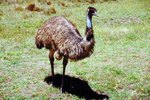
The golden eagle is an awe-inspiring sight for people lucky enough to watch one soar. Although not as easily recognizable as its bald-headed cousin, the golden eagle is equally magnificent. The golden eagle has beautiful plumage, regal bearing and superb flying and hunting prowess. The golden eagle is the national symbol of Mexico and a protected national treasure in the United States.
Vital Statistics
The golden eagle is North America’s largest bird of prey. It can grow to a length of 3 feet, with a wingspan of 6 to 7 feet. Its plumage is dark brown with flecks of gold coloring around the head and neck. The golden eagle has brown eyes, a yellow beak and talons that grow to 3 inches. Golden eagles' legs are feathered down to their talons. They typically live between 15 to 20 years but have been known to live as long as 30 years.
Habitat
The golden eagle is found throughout much of the northern hemisphere. You can find them in mountainous areas, canyon lands, riverside cliffs and bluffs and anywhere the rugged terrain creates frequent updrafts. They typically avoid developed areas and large stretches of forest. Golden eagles are territorial. A mated pair can maintain a territory as large as 60 square miles.
Diet
Like all raptors, golden eagles are carnivores and formidable hunters. They are large and powerful enough to take down an adult deer, but they typically feast on rodents, rabbits, reptiles, birds, fish and occasionally carrion or stolen prey from other birds. Their superb eyesight allows them to easily track down unwary prey. They can swoop down on their quarry at speeds up to 150 miles per hour, and the striking force of their powerful talons have been compared to the force of a bullet.
Mating and Nesting
Golden eagles usually mate when they are 4 years old. They stay with the same mate for years and often for life. They build their nests on high cliffs, tall trees or rocky crags, where predators can’t get to the eggs or eaglets. Often a pair of eagles will return and use the same nest for several years. Females lay up to four eggs, which hatch in 40 to 45 days. During this time, the male will bring food for the sitting female. The young will leave the nest in about three months.
Status
Golden eagles are a protected species in the United States. The U.S. Fish and Wildlife Service can fine you up to $10,000 if you possess a golden eagle feather or body part. In an effort to further protect these beautiful and majestic birds, some utility companies are modifying their power poles to reduce raptor electrocutions. The birds are so large that their wings and legs can touch two power lines at once to create an electrical circuit. New raptor-safe power pole construction standards mean a safer environment for the birds.
References
Photo Credits
-
Comstock Images/Comstock/Getty Images




